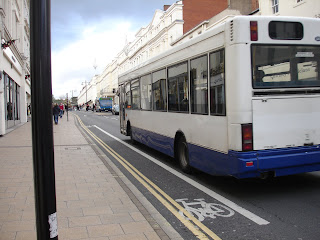Perhaps a little strange to be talking about Milton Keynes when the blog is about Leamington Spa and Assen but i have just returned from a trip to Milton Keynes and think that there are lessons to be learnt.
unfortunately I did the trip by car as I was delivering back all my equipment having just retired from my assessing with the Open University and carrying it all by train and bike would have been impossible.
I do , however, sometimes travel by train and use the Redways - the network of cycle/walking paths, so called due to the red tarmac.
Milton Keynes was a new town started in 1967 and designed on a grid network of roads and totally separate Redways. the roads are mostly dual carriageway and have a 70mph speed limit. The Redways follow some of the roads but are mainly totally separate and often dive under complex underpasses especially at junctions.
Now given this extensive network you would expect a large number of cyclists, well you would be wrong; cycling in Milton Keynes is not that great, I am unable to even find numbers! (was 4.2% in 1998)
So why should this be so, after all I am asking for cycling infrastructure like the Netherlands and here is a town with apparently that type of provision and it doesn't seem to work.
Is it true that the English are lazy, will jump in a car rather than walk a 100 metres or is the weather just too awful?
I think that we do indeed suffer from "car love" and a belief that cycling is hard work and that we will always get wet and cold, but there are enough people who don't and they should be out there on bikes.
My thoughts are that the road infrastructure is such that you can get across Milton Keynes in a very short time, parking is plentiful and cheap. so little incentive to give it up.
The Redways are poorly designed in parts, there are numerous dog walkers and pedestrians and the wander around often taking a longer route than the roads. The direction signposting is almost none existent and when it is often vandalised and points to strange destinations.
The low usage and the fact that they are quite hidden also worries some users who are afraid of being attacked, unjustifiably I think.
Perhaps one of the main reasons is the poor publicity which has been fuelled by comments from cycling activists, mainly sporting cyclists rather than ordinary people using bikes.
The chief critic is John Franklin author of Cycle Craft who contends that they are more dangerous than cycling on the 70mph dual carriageways and even round the roundabouts that drivers barely slow down for. He states "Cycling safety has long been a controversial subject in Milton Keynes. Many people perceive motor traffic to be the main danger to cyclists; cycle paths such as the Redways which keep cyclists away from motor vehicles are therefore thought de-facto to be the safest routes for cyclists to use. There is, however, considerable evidence to challenge this view. and proceeds to give that evidence including:
"At a considerable proportion of accident locations Redways are below national standards. Poor visibility - frequently due to vegetation - is the biggest single cause of accidents, but other common causes include sharp bends, steep gradients, bollards, slippery bridges, loose gravel (particularly on leisure routes) and mud (often a result of inadequate drainage). In short, features which are not compatible with the inherent limitations of a bicycle.
Another common accident cause is as a result of the very poor user discipline on Redways. Observation suggests that cycling on the left is more the exception than the rule and frequently cyclists and other users take insufficient care for the hazards that are present.
Arguably this is not helped by a complete absence of centre lines and other reminders to keep left, and the unsuitability of many paths for typical cycling speeds. 50% of respondents to the 1993 survey said that the Redways are not well suited for cycling at their preferred speed whilst others travel faster regardless.
Some of the most serious Redway injuries have been as a result of head-on collisions between cyclists; a type of accident that is a common cause of cycle path fatalities. On Redways, bad forward visibility, sharp bends and wrong-side riding have invariably been the cause of cyclists colliding head-on. Serious injury has also resulted after collisions with dogs, which may leap unforeseen from dense path-side vegetation." A lot of this seems to be the lack of cycle skills rather than the infrastructure.
Redway accidents seem to afflict all kinds of cyclist, including those who might be regarded as highly skilled. The unique environment of Redways is probably a reason. It may also be significant that some of the most serious road injuries have been suffered by people who normally cycle on Redways, but who have been forced to divert exceptionally through path closure, flooding, etc. Cycle paths are thought by some to lead to a decline in cycling skill."
If you want to see the whole article go to
http://www.cyclecraft.co.uk/digest/redway.html
This is I find a typical stance taken by many cyclists in the UK, usually long standing clubmen or racers who have cycled on roads for all their lives and believe that the introduction of cyclepaths will result in the loss of the right to use the roads. They see cycling as a sport or recreation, not as everyday transport.



















